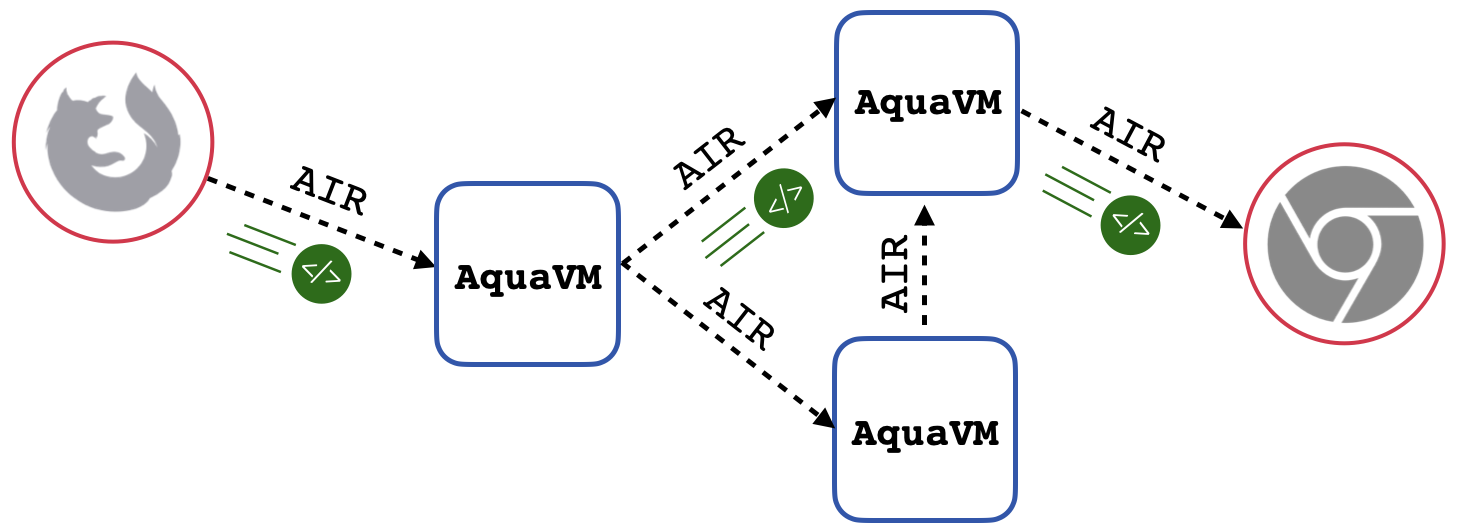BREAKING CHANGE:
1. Call values in the trace have CID references to structures that have call arguments' hash and CID references to values and tetraplets.
2. If call value is unused, it is serialized with `Unused` variant, and CID references are not stored.
Previous data scheme was (Scalar as an example, other cases are similar):
```
Scalar(CID<JValue>) ---<value_store>----> JValue
```
New data scheme is much more sophisticated:
```
Scalar(CID<ServiceResultAggregate>) ---+
|
+----<service_result_store>----------+
|
+-------> ServiceResultAggregate:
value_cid ------------<value_store>----> JValue
tetraplet_cid --------<tetraplet_store>----> SecurityTetraplet
argument_hash: String
```
`Stream` variant is similar, however, `Unused` is different: it has value CID only, but the value is not stored into the `value_store`:
```
Unused(Rc<CID<JValue>>) ---> X
```
Co-authored-by: Mike Voronov <michail.vms@gmail.com>
|
||
|---|---|---|
| .cargo | ||
| .github | ||
| air | ||
| air-interpreter | ||
| avm | ||
| benches | ||
| crates | ||
| docs | ||
| images | ||
| junk/cidify | ||
| tools | ||
| .gitignore | ||
| Cargo.lock | ||
| Cargo.toml | ||
| CHANGELOG.md | ||
| Config.toml | ||
| CONTRIBUTING.md | ||
| LICENSE | ||
| next-hardfork-changes.md | ||
| README.md | ||
| rust-toolchain.toml | ||
AquaVM
AquaVM executes compiled Aqua, i.e., Aqua Intermediate Representation (AIR) scripts, and plays an integral role in the implementation of the Fluence peer-to-peer compute protocol. Specifically, AquaVM allows expressing network choreography in scripts and composing distributed, peer-to-peer hosted services. Moreover, AquaVM plays a significant role in facilitating function addressability in the Fluence network, see Figure 1.

Figure 1: Stylized AquaVM And AIR Model
Since AquaVM compiles to Wasm, it can run in both client, such as browsers and Node.js apps, and server environments.
AquaVM: Interpreter Execution Model
AquaVM's execution model facilitates Fluence protocol's data push model implemented as a particle, i.e., a smart packet comprised of data, AIR, and some metadata. In this context, AquaVM can be viewed as a pure state transition function that facilitates particle updates, which includes state management of particle data by taking previous and current state to produce a new state and an updated list of peers and call requests in the remaining AIR workflow. In addition to local service call execution, AquaVM handles requests from remote peers, e.g., as a part of a parallel execution block, to call local services and handle the future response, see Figure 2.

Figure 2: AquaVM Interpreter Execution Model
In summary, the AquaVM execution model handles the topological hops for simple and advanced composition patters, such as (async) parallel service execution on one or multiple peers.
Aquamarine Intermediate Representation (AIR): IR for P2P Systems
AIR is an S-expression-based low-level language with binary form to come. It currently consists of fourteen instructions with more instructions to come. Semantics of AIR is inspired by π-calculus, λ-calculus, and category theory. Its syntax is inspired by Wasm Text Format (WAT) and Lisp. AIR scripts control the Fluence peer-to-peer network, its peers and even resources on other (p2p) networks, such as IPFS and Filecoin, e.g., Fluence IPFS library through Marine adapter services.
A description of AIR values and a list of AIR instructions together with examples of their usage can be found here. The main properties of AIR and its interface are discussed here.
A complete list of AIR instructions with examples of their usage can be found here. The fundamental contracts of the AquaVM interface, along with a more detailed interaction scheme can be found here.
Repository Structure
- air is the core of AquaVM
- air-interpreter is a crate to support different compilation targets (Marine and wasm-bindgen)
- avm
- crates
- air-lib contains all main crates for the core of AquaVM
- beautifier is an implementation of AIR-beautifier
- data-store defines a
DataStoretrait used by the Fluence node - interpreter-wasm is a crate for better integration of compiled Wasm code into the Fluence node
- testing-framework is an implementation of the framework that improves test writing experience
- tools contains AquaVM-related tools
Support
Please, file an issue if you find a bug. You can also contact us at Discord or Telegram. We will do our best to resolve the issue ASAP.
Contributing
Any interested person is welcome to contribute to the project. Please, make sure you read and follow some basic rules.
License
All software code is copyright (c) Fluence Labs, Inc. under the Apache-2.0 license.

